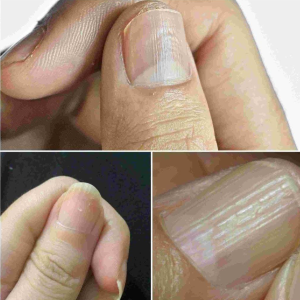
The REAL Causes of Vertical Ridges on Your Nails – 1000 Words
Vertical ridges on fingernails—those faint or sometimes prominent lines running from the cuticle to the tip—are surprisingly common. While they might seem worrisome, in most cases, they are harmless. However, there are instances where they may signal underlying health conditions. Let’s break down what causes them, what they may mean, and when you should be concerned.
Understanding Nail Anatomy
To understand what causes vertical ridges, you need to know how nails grow. Nails are made of keratin, the same protein found in your hair and skin. They grow from the matrix, a tissue beneath the cuticle. As new cells are produced, older cells are pushed forward, forming the hard nail plate.
Any disruption in this process—whether from aging, trauma, or systemic illness—can affect how the nail appears, including the development of ridges.
What Are Vertical Ridges?
Vertical ridges are lines or grooves that run up and down the nail, from the base (cuticle) to the tip. They differ from horizontal ridges (also called Beau’s lines), which typically indicate more serious systemic disruptions.
Vertical ridges are usually not a cause for concern, but their appearance can be influenced by a variety of factors.
Common Causes of Vertical Ridges
1. Aging (Most Common Cause)
Just as our skin forms wrinkles with age, nails can develop ridges. These lines often become more noticeable in your 30s and beyond.
-
Why it happens: As we age, the rate of cell turnover in the nail matrix slows down. This can lead to uneven keratin production, resulting in ridges.
-
What it looks like: Thin, straight lines that are more visible under bright light.
Bottom line: If you’re aging and notice ridges without other symptoms, this is usually normal.
2. Dehydration of the Nail Plate
Nails need moisture and oils to remain flexible. When they dry out, ridging can occur.
-
Causes of dryness:
-
Overwashing hands
-
Excessive use of hand sanitizers or acetone-based nail polish removers
-
Cold weather
-
-
What to do:
-
Use cuticle oil and hand creams
-
Wear gloves in cold conditions or while doing dishes
-
3. Nutritional Deficiencies
Deficiencies in certain vitamins and minerals can affect nail health.
-
Key nutrients:
-
Biotin (Vitamin B7) – Essential for keratin production
-
Iron – Iron deficiency anemia can cause brittle nails and ridges
-
Magnesium and zinc – Support healthy cell growth
-
-
Signs to look for:
-
Ridges along with spoon-shaped nails or pale nail beds could signal iron deficiency
-
-
Treatment:
-
Dietary changes or supplements (after consulting a doctor)
-
4. Trauma or Injury to the Nail Matrix
Even small injuries to the base of the nail (like slamming a finger in a door or frequent nail biting) can damage the matrix and lead to ridges.
-
What happens: The trauma disrupts the even production of keratin
-
How long it lasts: Until the damaged nail grows out completely (typically 4–6 months for fingernails)
5. Eczema and Skin Conditions
People with eczema, psoriasis, or other inflammatory skin conditions often notice changes in their nails.
-
What you might see:
-
Ridges
-
Pitting (small dents)
-
Discoloration
-
-
Why it happens: Inflammation can affect nail matrix function
-
Treatment: Managing the underlying skin condition often improves nail appearance
6. Medical Conditions
While most vertical ridges are harmless, some systemic illnesses can cause noticeable changes.
Thyroid Disease
-
Both hyperthyroidism and hypothyroidism can lead to brittle, ridged nails.
-
Nails may grow slowly or split.
Peripheral Vascular Disease
-
Poor circulation affects nail nutrition and health.
Rheumatoid Arthritis
-
Chronic inflammation impacts many tissues, including nails.
-
Patients may develop vertical ridges, brittleness, or even color changes.
Lichen Planus
-
An inflammatory condition affecting skin and nails.
-
Can lead to deep, longitudinal grooves or nail loss.
7. Genetics
If vertical ridges run in your family, they might just be part of your natural nail makeup.
-
No treatment is needed unless the ridges change appearance drastically.
When to Be Concerned
Not all ridges are benign. Watch for these red flags:
-
Sudden onset of deep ridges
-
Change in color (brown, black, or red streaks)
-
Splitting or crumbling nails
-
Horizontal ridges (may suggest illness or infection)
-
Associated pain or swelling
In such cases, consult a dermatologist or healthcare provider. Nail changes can sometimes be the first sign of serious systemic illness.
How to Improve the Appearance of Vertical Ridges
Even if harmless, ridged nails can be bothersome. Here are safe ways to improve their look:
-
Buffing: Light buffing smooths the surface but must be done gently to avoid thinning the nail.
-
Nail oils: Keep the cuticle and nail plate hydrated to reduce appearance.
-
Biotin supplements: Can strengthen nails and reduce brittleness.
-
Protective base coats: Ridge-filling nail polishes can smooth the appearance instantly.
-
Balanced diet: Focus on whole foods rich in B vitamins, iron, and zinc.
Final Thoughts
Vertical ridges on your nails are usually a normal part of aging or the result of minor issues like dryness or nutritional deficiencies. However, it’s always wise to monitor for sudden changes or accompanying symptoms that could point to an underlying health problem.
Your nails can tell a story about your overall health—sometimes whispering age, other times hinting at deeper imbalances. By paying attention to these small signs and practicing good nail care, you can keep your hands healthy and your concerns at bay.
